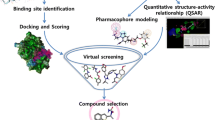Abstract.
Structure-based design has emerged as a new tool in medicinal chemistry. A prerequisite for this new approach is an understanding of the principles of molecular recognition in protein-ligand complexes. If the three-dimensional structure of a given protein is known, this information can be directly exploited for the retrieval and design of new ligands. Structure-based ligand design is an iterative approach. First of all, it requires the crystal structure or a model derived from the crystal structure of a closely related homolog of the target protein, preferentially complexed with a ligand. This complex unravels the binding mode and conformation of a ligand under investigation and indicates the essential aspects determining its binding affinity. It is then used to generate new ideas about ways of improving an existing ligand or of developing new alternative bonding skeletons. Computational methods supplemented by molecular graphics are applied to assist this step of hypothesis generation. The features of the protein binding pocket can be translated into queries used for virtual computer screening of large compound libraries or to design novel ligands de novo. These initial proposals must be confirmed experimentally. Subsequently they are optimized toward higher affinity and better selectivity. The latter aspect is of utmost importance in defining and controlling the pharmacological profile of a ligand. A prerequisite to tailoring selectivity by rational design is a detailed understanding of molecular parameters determining selectivity. Taking examples from current drug development programs (HIV proteinase, t-RNA transglycosylase, thymidylate synthase, thrombin and, related serine proteinases), we describe recent advances in lead discovery via computer screening, iterative design, and understanding of selectivity discrimination.
Similar content being viewed by others
Author information
Authors and Affiliations
Additional information
Electronic Publication
Rights and permissions
About this article
Cite this article
Klebe, G. Recent developments in structure-based drug design. J Mol Med 78, 269–281 (2000). https://doi.org/10.1007/s001090000084
Received:
Accepted:
Published:
Issue Date:
DOI: https://doi.org/10.1007/s001090000084




